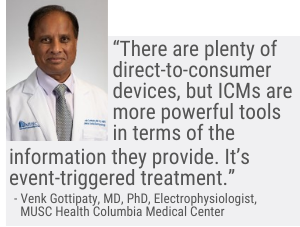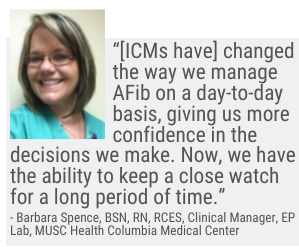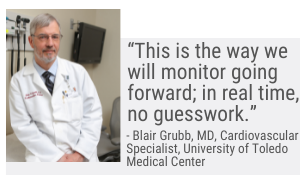The world of EP keeps getting busier and busier. Greater visibility, more referrals to electrophysiology for rhythm issues — namely atrial fibrillation (AFib)—and a surge in the pool of arrhythmia cases has brought an uptick in patient volumes; a factor of five in the last two years, as veteran electrophysiologist Venk Gottipaty, MD, PhD, has seen at MUSC Health Columbia Medical Center (CMC) in Columbia, S.C.
 More durable and sensitive implantable cardiac monitors (ICMs) are playing a bigger role in helping physicians, NPs, PAs and nurses interrogate rhythm issues in near real-time with improved accuracy. Data-driven decision-making requires good data to be successful. So when it comes to choosing the right ICM, physicians value high-fidelity signals and ease of implantation and interrogation most.
More durable and sensitive implantable cardiac monitors (ICMs) are playing a bigger role in helping physicians, NPs, PAs and nurses interrogate rhythm issues in near real-time with improved accuracy. Data-driven decision-making requires good data to be successful. So when it comes to choosing the right ICM, physicians value high-fidelity signals and ease of implantation and interrogation most.
“There are a whole lot of undiagnosed rhythm issues,” says Gottipaty. “We’ve needed a better rhythm management strategy. There are plenty of direct-to-consumer devices, but ICMs are more powerful tools in terms of the information they provide. It’s event-triggered treatment.”
Part long-term electrocardiogram (ECG) and part state-of-the-art Holter monitor, ICMs can track a patient’s heart for more than 5 years, specifically with the longevity of Biotronik’s BIOMONITOR IIIm. The clearest, high-definition ECGs allow the most effective diagnosis every time, over time. Patients gain greater peace of mind with around-the-clock monitoring, while practices appreciate the gains in efficiency.
Gottipaty typically inserts high-fidelity ICMs post-ablation, taking advantage of the anesthesia on board. Monitoring to him offers greater flexibility in managing the patient, letting him know, for example, when it’s safe to take the patient off anticoagulation altogether or maybe move him or her to aspirin therapy. Internal monitors also help Gottipaty decide if other patients would benefit from a pacemaker or another therapeutic intervention. “Or on the other side, we can determine if a patient has a non-rhythm issue and treatment isn’t needed,” he says. “It works to our advantage both ways.”
Clinicians are no longer just hoping to “catch” a rhythm problem when a patient is in the hospital. “It’s been a real game- changer,” says Barbara Spence, BSN, RN, RCES, who works with Gottipaty as the clinical manager of MUSC Health Columbia Medical Center’s EP lab. “[ICMs have] changed the way we manage AFib on a day-to-day basis, giving us more confidence in the decisions we make. Now, we have the ability to keep a close watch for a long period of time. All of that insight has made a huge impact for us and for these patients. We tell patients they’re going to have a 24/7 EKG that can help give us the information we need.”
changer,” says Barbara Spence, BSN, RN, RCES, who works with Gottipaty as the clinical manager of MUSC Health Columbia Medical Center’s EP lab. “[ICMs have] changed the way we manage AFib on a day-to-day basis, giving us more confidence in the decisions we make. Now, we have the ability to keep a close watch for a long period of time. All of that insight has made a huge impact for us and for these patients. We tell patients they’re going to have a 24/7 EKG that can help give us the information we need.”
MUSC Health Columbia Medical Center, like other facilities across the country, has seen what Spence describes as a huge increase in ICM placements over the past year or so. “I think the physicians are realizing it’s a valuable tool,” she says. “We’re seeing physicians who didn’t implant devices before starting to use them.”
It starts with signal strength
One thing is central to effective ICM diagnosis and patient management: high-fidelity ECG recordings. “We benefit from both the higher quality tracings and algorithms,” notes Gottipaty who favors BIOMONITOR III and BIOMONITOR IIIm ICMs for these kinds of placements. “There are always clinical scenarios where that extra level of fidelity in terms of P wave visibility and R wave amplitude make a difference. We can diagnose with more accuracy and greater confidence as we distinguish kinds of arrhythmia. We can see how things evolve and change with disease progression.”
Blair Grubb, MD, a cardiovascular specialist at the University of Toledo Medical Center, sees a similar surge in his team’s use of ICMs. “This is creating a new world,” he says, “monitoring people continuously allows us to see a spectrum of different rhythm problems and often not only the one we were originally looking for. We’re seeing patterns and have written papers about the findings. Postural tachycardiac syndrome is one example. It’s usually characterized by tachycardia, but in our research with these devices we’ve shown that up to one third of patients also have severe bradycardia.”
 An EP specialist for several decades — even working as an electrician before medical school—Grubb often chooses Biotronik ICMs for patients who may benefit from a little extra attention. The utility of ICMs has grown in recent years. Patients who benefit from the BIOMONITOR IIIm are best described as those with Afib, suspected Afib, syncope, idiopathic strokes, TIA, hypertrophic cardiomyopathy, bradycardia, tachycardiac-bradycardia syndrome and long QT syndrome.
An EP specialist for several decades — even working as an electrician before medical school—Grubb often chooses Biotronik ICMs for patients who may benefit from a little extra attention. The utility of ICMs has grown in recent years. Patients who benefit from the BIOMONITOR IIIm are best described as those with Afib, suspected Afib, syncope, idiopathic strokes, TIA, hypertrophic cardiomyopathy, bradycardia, tachycardiac-bradycardia syndrome and long QT syndrome.
“The longer the distance you’re recording, the bigger the signal is going to be,” he explains. “When the pole is further away, increasing the recording distance, you’re always going to get a better recording. The [Biotronik ICMs] offer a longer vector that makes them slightly longer than other ICMs, but they also reap significant benefits in superior signal morphology that others do not. It’s becoming my device of choice because it’s durable and reliable too.”
Better monitoring over time enables physicians to pick up longer and longer periods of bradycardia. Grubb points out that the same fibrotic changes that occur within the atrial tissue that leads to AFib also will affect the sinus node as its part of the atrial tissue. “So the very same pathophysiologic processes that lead to AFib lead to sinus node dysfunction,” he says.
As Grubb and his team have watched these patients more long-term, they’re starting to see both occur. ICMs help with the decision-making that comes with tracking longer and longer pauses. “I am in favor of intervening prior to a patient having a fall,” he says. “That’s good for the patient and for society.”
Ease of interrogating that data is another big priority for Grubb. He says he prefers an ICM that allows him to access the data whenever he wants, something that Biotronik devices allow and some other vendors’ do not.
“I don’t like it when the ICM won’t let me see the recordings myself,” he says. “I don’t want to go to a website and login. I like to download them, manipulate the settings, enlarge the files and examine them as needed.”
Better patient care
Long-term monitoring also helps patients feel like their concerns are being taken seriously—no small feat in a world where telehealth and appointments-by-phone are more and more common.
Spence says she has noticed a “sense of relief” in patients when they find out they’re going to get a device.
“A lot of patients almost feel like they aren’t being heard, and it can be really frustrating for them,” she says. “Maybe they come in and know something’s going on with their heart, but the doctors just don’t see anything. When we offer them the ICM, they feel relieved almost immediately—you can see in their face. It’s a big thing for them.”
That ability to monitor patients wherever they are — not just in the hospital, not just in the doctor’s office — has really increased the recognition of AFib, Gottipaty adds. “AFib has been under-recognized and undertreated for a long time. The improvement in the ability to diagnose is tremendous. And I do believe we avert harmful events like stroke.”
Grubb also sees a clear advantage in this more proactive approach to patient monitoring. When treating elderly patients, for instance, the recordings can provide early warnings that they may be approaching a heart issue that could land them in the emergency department.
“Up to 40% of falls have cardiac origins,” Grubb explains. “If an elderly patient breaks a hip and gets an emergency replacement, he or she will probably never walk again—and then could end up in a nursing home. Elective hip replacements, though, do much better. So that’s another way these ICMs can help us identify a risk and intervene before the disaster happens.”
Long-term monitoring also can protect asymptomatic patients more likely to experience adverse cardiac events due to their family history.
“Sometimes, a patient may not even fit the normal criteria for a device,” Grubb says. “If a teenager has the genes for long QT syndrome, for example, putting in the ICM can help catch issues before it’s too late. It’s going to make a lot of patients — and their families — really happy if we can stop that from happening.”
ICMs help the complex patient too. “AFib is pretty straightforward, but if you’re diagnosing something like Wolff-Parkinson-White (WPW) syndrome, you really need that strong signal,” Spence says. “You need to see things like the P wave and the QRS complex clearly. Playing with signal gain only gets you so far. Once you see the signals you can get from these higher fidelity monitors, it’s what you wish you had for every patient.”
The sky’s the limit
The rise of ICMs — and their impact on the treatment of AFib, stroke and beyond—has directly helped emphasize EP’s importance to the rest of the hospital.
“Back in the late 90s, we were the geeks in the hospital closet,” Gottipaty says, laughing. “Nobody knew who we were or what we did. But the presence of EP in cardiology — and other specialties as wel — has increased over time. Now, people know EP exists. They know we’re here.”
More physicians are using long-term cardiac monitoring on more patient types. Over time, the devices will become smaller and more powerful. They’re also getting better at “sifting through data and alerting us,” as Gottipaty says. “We have confidence in what we are seeing in that data, circling back to the quality of the waves. That matters. The slightly more complex patient is where the implantable market will remain for quite some time. The patient who has just had a heart attack, a first-time ablation. Less proactive patients are candidates for implantables as well because we can manage the illness as opposed to them owning it.”
more powerful. They’re also getting better at “sifting through data and alerting us,” as Gottipaty says. “We have confidence in what we are seeing in that data, circling back to the quality of the waves. That matters. The slightly more complex patient is where the implantable market will remain for quite some time. The patient who has just had a heart attack, a first-time ablation. Less proactive patients are candidates for implantables as well because we can manage the illness as opposed to them owning it.”
Practices, too, are seeing the upside of ICMs, namely the quicker diagnosis, less evaluation and less overhead for long-term management. There’s also less need for in-person follow ups. Think of it this way: More home, less office. Physicians, PAs, NPs and nurses can identify problems and actionable items from afar through alerts or patient concerns and intervene to change therapy in a short period of time. Most patients remain at home instead of needing a trip to the hospital, perhaps with a change in medication. Or when an intervention is needed, patients can be alerted quickly and head to the hospital.
ICMs are the way of the future, as Grubb notes, and momentum is continuing to build. “This is the way we will monitor going forward; in real time, no guesswork,” he says. “Testing in the hospital and making leaps of faith, we’ve moved past that. We can see the rhythms, they’re right in front of us, real time if we need, and we can offer the best way to treat patients. We are confident and so are they.”

